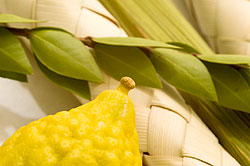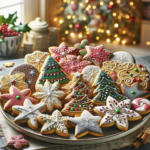Etrog, Lulav and the Four Species
“and you shall take of yourselves on the first day (of Sukkot) the fruit of a goodly tree, a palm branch, the myrtle branch, and the willow of the brook; and you shall rejoice before the L-rd your G-d seven days”
Leviticus 23
Of the many symbols associated with Sukkot the most important are the Four Species.
 The Four Species are:
The Four Species are:
Etrog
The fruit of the goodly tree, also known as the citron
Palm branch – know as the lulav
Myrtle – the hadas
Willow – the aravah
Together these items make up theEtrog and Lulav, which are important ingredients in the celebration of Sukkot in the synagogue .
When choosing an etrog, look for one that is clean and free of blemishes. Make sure that the crown is intact. A texture that is rippled is preferred over a smooth finish. And a green etrog is recommended over a yellow one as the yellow is already ripe, while the green one, which will ripen quickly, lasts longer.
To make the Lulav you will need to gather a palm branch (also called a lulav), myrtle branches (hadas), and willow branches (aravah). When choosing the Etrog and the Lulav, remember it is important that they be “beautiful” or hadar.
The palm branch should be as green and straight as possible. Make sure that the center spinal leaf does not spilt and the leaves are not damaged. Choose 3 myrtle branches that are between 12 and 15 inched long. As well as two willow branches which need to be longer than the myrtle. Then bind the myrtle and willow to the lulav with a piece of string or a rubber band.
When used in temple the Lulav, in the right hand, and the Etrog, in the left, are carried as the Hallel (a group of psalms) are sung. At the end of the service the Etrog and Lulav are again held during the Hoshanot, the processional in which the entire congregation circles the sanctuary singing hymns of joy and thanksgiving.
Related Video: LeviTV: Sukkot – Lulav 101 (Good explaination of the 4 Species)



